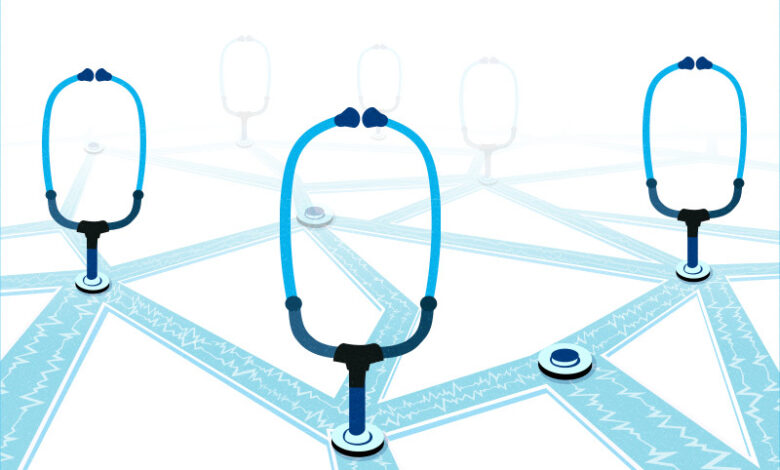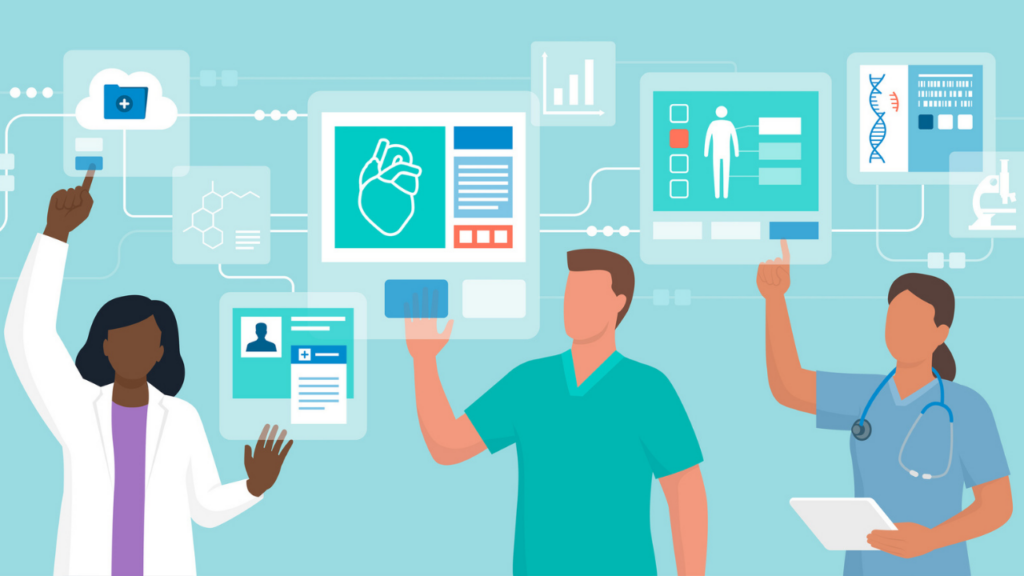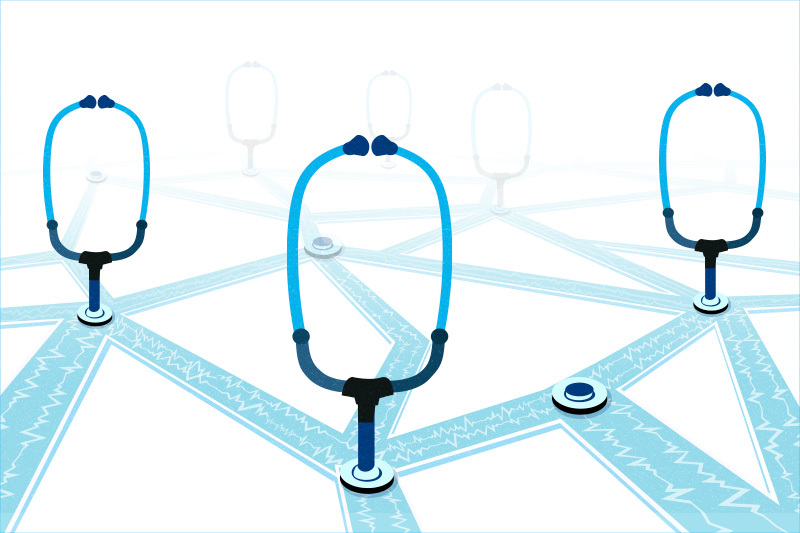
More Hospitals Are Electronically Sharing Health Information
More hospitals are electronically sharing health information, and it’s changing the healthcare landscape dramatically! This shift towards interconnected systems promises a future where patient care is smoother, more efficient, and ultimately, better. But this exciting advancement isn’t without its hurdles. We’ll explore the incredible benefits, the challenges faced in implementation, and what the future might hold for this revolutionary approach to healthcare data.
From improved diagnostic accuracy and reduced medical errors to enhanced patient communication and engagement, the potential upsides are huge. However, we also need to address crucial concerns surrounding data privacy, security, and the complexities of navigating diverse technological systems and regulatory frameworks. This post delves into the nitty-gritty, providing a balanced perspective on this rapidly evolving field.
Benefits of Electronic Health Information Sharing

Source: europeanlung.org
The shift towards electronic health information sharing represents a monumental leap forward in healthcare. It’s no longer enough for hospitals to operate in silos; the seamless exchange of patient data is crucial for delivering safe, efficient, and high-quality care. This interconnectedness, often referred to as interoperability, unlocks a wealth of benefits for both patients and the healthcare system as a whole.Increased interoperability between hospitals significantly improves patient care.
Imagine a scenario where a patient experiencing a medical emergency is transferred between facilities. With electronic health record (EHR) sharing, the receiving hospital instantly accesses the patient’s complete medical history, including allergies, medications, and previous diagnoses. This eliminates the risk of critical information being overlooked or lost during the transfer, leading to better-informed treatment decisions and potentially saving lives.
Improved Patient Care Through Shared EHRs
Shared electronic health records dramatically enhance the quality of patient care. By providing a comprehensive view of a patient’s medical history across different healthcare settings, clinicians can make more accurate diagnoses, avoid medication errors, and personalize treatment plans more effectively. For instance, if a patient has a history of adverse reactions to certain antibiotics, this information will be readily available to any healthcare provider involved in their care, preventing potentially dangerous situations.
It’s amazing how much more hospitals are electronically sharing health information these days, leading to better coordinated care. For example, if a patient’s electronic records show a history of carpal tunnel syndrome, their doctor might suggest exploring non-surgical options first, like those outlined in this helpful guide: ways to treat carpal tunnel syndrome without surgery. This seamless data sharing ultimately improves patient outcomes, and that’s a huge step forward in healthcare.
Furthermore, the accessibility of complete records allows for better coordination of care between specialists, ensuring a consistent and holistic approach to treatment.
Streamlined Information Exchange and Healthcare Efficiency
The efficient exchange of electronic health information significantly boosts healthcare efficiency. Time previously spent on manual chart reviews, phone calls, and faxing is drastically reduced. This frees up valuable time for healthcare professionals to focus on patient care, resulting in improved productivity and potentially shorter wait times for patients. Consider the administrative burden involved in transferring a patient’s records between a hospital, a specialist’s office, and a rehabilitation center.
With electronic sharing, this process becomes almost instantaneous, minimizing delays and improving the overall patient experience. Moreover, the reduced paperwork also contributes to cost savings for healthcare providers.
Cost-Benefit Analysis of Electronic vs. Traditional Information Sharing
The following table compares the costs and benefits of electronic health information sharing against traditional methods:
| Feature | Electronic Sharing | Traditional Methods (Paper-based) |
|---|---|---|
| Cost of Implementation | High initial investment in software and infrastructure | Relatively low initial cost |
| Ongoing Costs | Ongoing maintenance, software updates, and staff training | Costs associated with storage, retrieval, and transportation of paper records |
| Time Efficiency | Significantly faster access to information | Time-consuming retrieval and review of paper records |
| Error Rate | Lower error rate due to automated processes | Higher error rate due to manual handling and potential for lost or misplaced records |
| Data Security | Potentially higher security risks if not properly implemented | Risk of loss, damage, or unauthorized access to paper records |
| Accessibility | Improved access to information for multiple healthcare providers | Limited access; records may be geographically dispersed |
While the initial investment in electronic health information sharing is substantial, the long-term benefits in terms of improved patient care, increased efficiency, and reduced errors far outweigh the costs. The reduction in medical errors alone can lead to significant cost savings by preventing hospital readmissions and complications. Furthermore, the improved coordination of care contributes to better patient outcomes and reduces the overall burden on the healthcare system.
Challenges and Barriers to Implementation
The transition to widespread electronic health information sharing (EHIS) isn’t without its hurdles. While the benefits are clear, significant technological, privacy, regulatory, and logistical obstacles stand in the way of seamless interoperability across healthcare systems. Overcoming these challenges requires a multi-faceted approach involving collaboration between healthcare providers, technology developers, policymakers, and patients themselves.
Technological Hurdles to EHIS
Interoperability remains a significant technological challenge. Different healthcare systems often use incompatible electronic health record (EHR) systems, making the exchange of data difficult and costly. This lack of standardization creates a fragmented landscape where data silos hinder efficient care coordination. For example, a patient’s allergy information might be present in one system but inaccessible to another, leading to potential adverse events.
Further complicating matters is the need for robust data exchange infrastructure, including reliable networks and secure communication protocols. The cost of upgrading existing systems and implementing new technologies can also be prohibitive for smaller healthcare organizations, exacerbating the digital divide.
Privacy and Security Concerns in EHIS
The sensitive nature of health information necessitates robust security measures. Data breaches can have devastating consequences for patients, including identity theft, financial loss, and reputational damage. The sheer volume of data involved in EHIS increases the risk of unauthorized access or data leakage. Furthermore, ensuring the confidentiality, integrity, and availability of patient data requires sophisticated security protocols, regular audits, and staff training.
Maintaining patient trust in the security of their health information is paramount, and any perceived lack of security can discourage adoption of EHIS initiatives. Compliance with regulations like HIPAA in the US and GDPR in Europe is crucial in mitigating these risks.
Regulatory and Legal Frameworks Governing EHIS
The exchange of health information is governed by a complex web of regulations and laws designed to protect patient privacy and ensure data security. These regulations vary by jurisdiction and often include requirements for patient consent, data encryption, and audit trails. The complexities of navigating these legal frameworks can be daunting for healthcare organizations, potentially hindering their willingness to participate in EHIS initiatives.
The lack of harmonization across different jurisdictions further complicates the issue, making cross-border data exchange particularly challenging. The constant evolution of these legal frameworks also requires ongoing adaptation and compliance efforts.
Successful Strategies for Overcoming Challenges
Several strategies have proven effective in overcoming the challenges of EHIS. The adoption of standardized data formats, such as FHIR (Fast Healthcare Interoperability Resources), facilitates seamless data exchange between different EHR systems. Investing in robust cybersecurity infrastructure and implementing comprehensive data protection policies are crucial for mitigating privacy and security risks. Furthermore, strong collaboration between healthcare organizations, technology vendors, and regulatory bodies is essential for developing effective EHIS strategies.
Successful implementations often involve pilot projects to test new technologies and processes, followed by phased rollouts to minimize disruption and maximize user adoption. For example, some healthcare systems have achieved success by focusing on specific use cases, such as medication reconciliation or care coordination for chronic conditions, to demonstrate the tangible benefits of EHIS. These targeted approaches can build momentum and demonstrate the value of EHIS to stakeholders.
Impact on Patient Outcomes and Experience
The electronic sharing of health information is revolutionizing healthcare, profoundly impacting patient outcomes and the overall patient experience. Improved access to comprehensive patient data empowers healthcare providers to make more informed decisions, leading to better diagnoses, more effective treatments, and enhanced patient safety. This interconnectedness also fosters more efficient communication and greater patient engagement in their own care.Improved access to a patient’s complete medical history, including lab results, imaging reports, and medication lists from various providers, significantly enhances diagnostic accuracy and treatment decisions.
Imagine a scenario where a patient with a complex medical history sees a new specialist. With electronic health information sharing, the specialist immediately has access to all previous records, eliminating the need for repeated tests and potentially uncovering overlooked details that could influence diagnosis and treatment planning. This leads to quicker and more precise diagnoses, preventing delays and potentially life-threatening misdiagnoses.
Diagnostic Accuracy and Treatment Decisions
Access to complete and up-to-date patient information allows healthcare professionals to avoid diagnostic errors stemming from fragmented information. For example, a patient presenting with symptoms of heart failure might have a history of undiagnosed hypertension recorded in a separate system. With electronic sharing, this critical information is readily available, preventing misdiagnosis and enabling appropriate treatment for both conditions. Furthermore, the ability to compare data across multiple providers allows for a more holistic understanding of a patient’s condition, leading to more personalized and effective treatment plans.
This is especially crucial in managing chronic conditions that require ongoing care from multiple specialists.
Patient Safety and Error Reduction
Electronic health information sharing plays a crucial role in enhancing patient safety by reducing medical errors. Medication reconciliation, a critical step in preventing adverse drug events, is significantly improved through access to a complete medication history. Alerts and warnings integrated into electronic health records (EHRs) can flag potential drug interactions or allergies, preventing harmful medication errors. Similarly, access to a patient’s allergy history across different healthcare settings prevents accidental exposure to allergens, a significant safety concern.
Studies have shown a direct correlation between the implementation of EHRs with robust data sharing capabilities and a reduction in medication errors and other preventable adverse events.
Improvements in Patient Experience
Better information flow leads to several improvements in the patient experience.
- Reduced wait times: Faster access to information streamlines appointments and reduces the need for repetitive testing.
- Improved coordination of care: Patients benefit from better communication and collaboration among their healthcare providers.
- Increased patient convenience: Access to online portals allows patients to review their medical records, request appointments, and communicate with their providers securely.
- Enhanced patient engagement: Patients are empowered to participate more actively in their care when they have access to their complete medical history and can easily share it with their providers.
The improved coordination of care, facilitated by shared information, reduces the burden on patients who no longer need to repeatedly explain their medical history to different providers. This creates a more efficient and less stressful experience for the patient.
It’s amazing how many more hospitals are electronically sharing health information these days, improving care coordination and patient safety. This interconnectedness becomes even more significant considering the implications of Robert F. Kennedy Jr. clearing a key hurdle on his path to becoming HHS Secretary, as reported here: rfk jr clears key hurdle on path to hhs secretary.
His potential influence on healthcare policy could drastically shape how this data is managed and utilized, further impacting the future of electronic health information sharing across hospitals nationwide.
Improved Patient Communication and Engagement
Patient portals, a key feature of many EHR systems, allow patients secure access to their medical records, lab results, and appointment information. This empowers patients to take a more active role in managing their health. The ability to communicate directly with their healthcare providers through secure messaging systems facilitates timely clarification of questions and concerns, promoting better understanding and adherence to treatment plans.
Furthermore, some EHR systems incorporate patient education materials and tools for self-management of chronic conditions, further enhancing patient engagement and improving health outcomes. For instance, a diabetic patient can use a portal to track their blood sugar levels and share this data directly with their physician, enabling proactive adjustments to their treatment plan.
Future Trends and Developments
The future of electronic health information sharing is bright, poised for significant advancements driven by technological innovation and a growing emphasis on patient-centric care. We’re moving beyond simple data exchange towards a more intelligent, secure, and interoperable system that promises to revolutionize healthcare delivery.The integration of various technologies will redefine how health information is managed and utilized, leading to more efficient processes and improved patient outcomes.
This evolution will necessitate addressing current challenges and proactively mitigating potential risks associated with data security and privacy.
Artificial Intelligence in Data Analysis and Sharing
Artificial intelligence (AI) is set to play a transformative role in enhancing the analysis and sharing of electronic health information. AI algorithms can analyze vast datasets to identify patterns, predict risks, and personalize treatment plans with unprecedented accuracy. For instance, AI-powered diagnostic tools can analyze medical images to detect diseases earlier and more accurately than human clinicians alone, while predictive models can identify patients at high risk of developing certain conditions, enabling proactive interventions.
This enhanced analytical capability translates to more effective resource allocation, improved clinical decision-making, and ultimately, better patient outcomes. The use of AI in analyzing genomic data is also expected to personalize medicine, allowing for targeted therapies based on an individual’s genetic makeup. Imagine a future where AI assists doctors in making near real-time diagnoses and treatment recommendations, pulling relevant data from a patient’s complete electronic health record (EHR) across different healthcare systems.
Blockchain Technology and Data Security, More hospitals are electronically sharing health information
Blockchain technology, known for its secure and transparent nature, offers a promising solution to enhance data security and interoperability in electronic health information sharing. Its decentralized and immutable ledger system can ensure the integrity and authenticity of health records, reducing the risk of data breaches and unauthorized access. Furthermore, blockchain can facilitate secure and efficient data sharing between different healthcare providers and patients, improving interoperability without compromising privacy.
Consider a scenario where a patient’s medical history is stored on a blockchain-based platform, allowing authorized healthcare providers to access only the necessary information while maintaining a complete and auditable record of all data accesses. This enhanced security and transparency could build greater trust in the system and encourage wider adoption of electronic health information sharing.
It’s amazing to see more hospitals electronically sharing health information, leading to better coordinated care. This interconnectedness is further boosted by advancements like those highlighted in this article about ai most exciting healthcare technology center connected medicine upmc , showcasing how AI and connected medicine are revolutionizing the field. Ultimately, this all contributes to a more efficient and effective system where patient data flows seamlessly, improving overall healthcare outcomes.
A Future Healthcare System with Seamless Information Sharing
Imagine a future healthcare system where a patient’s complete medical history, including lab results, imaging data, and doctor’s notes, is instantly accessible to any authorized healthcare provider, regardless of location or system. This seamless information sharing would eliminate the delays and inefficiencies associated with manual data transfer, leading to more coordinated and effective care. For example, a patient experiencing a medical emergency in a different city could receive immediate and appropriate treatment, as their complete medical history is readily available to the attending physician.
This integrated system would also empower patients, allowing them to access and manage their own health information easily and securely, fostering greater patient engagement and improved health outcomes. This system would rely on robust security measures, such as blockchain technology and advanced encryption, to ensure patient privacy and data integrity. The system would also incorporate AI-powered tools to analyze the data, providing valuable insights for clinicians and researchers.
Case Studies of Successful Implementations
The successful implementation of electronic health information sharing (EHIS) hinges on a multifaceted approach encompassing technological infrastructure, robust data governance, and a committed workforce. Several healthcare systems have demonstrated the feasibility and benefits of EHIS, offering valuable lessons for others embarking on similar journeys. Examining these case studies reveals common success factors and highlights the diverse strategies employed to overcome implementation challenges.
Intermountain Healthcare’s Regional Health Information Exchange (RHIO)
Intermountain Healthcare, a large integrated healthcare system in Utah and Idaho, has been a pioneer in EHIS. Their RHIO, built over many years, connects numerous hospitals, clinics, and other healthcare providers across the region. This allows for seamless access to patient records, improving care coordination and reducing medical errors. Their approach involved a phased rollout, starting with a limited number of providers and gradually expanding the network.
Key components included a robust technical infrastructure, a standardized data exchange format, and strong governance structures to ensure data security and privacy.
- Phased implementation minimizing disruption.
- Strong leadership and dedicated project teams.
- Focus on interoperability and data standardization.
- Robust security and privacy protocols.
- Continuous monitoring and improvement of the system.
The Mayo Clinic’s Nationwide Network
The Mayo Clinic, known for its expertise in patient care and research, has leveraged EHIS to facilitate collaboration across its multiple campuses and with external providers. Their system emphasizes a secure and centralized platform, enabling efficient access to patient data regardless of location. This facilitates better coordination of care, especially for patients with complex medical histories requiring input from multiple specialists across different sites.
The Mayo Clinic’s success stems from its commitment to technological innovation, its strong internal IT infrastructure, and a culture of data sharing.
- Centralized data repository with strong security measures.
- Investment in advanced technologies for data integration.
- Strong emphasis on data quality and standardization.
- Dedicated IT support and training for staff.
- Continuous improvement driven by data analytics.
Comparison of Approaches
While both Intermountain Healthcare and the Mayo Clinic achieved success in EHIS, their approaches differed. Intermountain Healthcare opted for a regional, collaborative model, building a RHIO that involved numerous independent organizations. The Mayo Clinic, in contrast, focused on a centralized, internally managed system spanning its own extensive network. Both approaches underscore the importance of careful planning, strong leadership, and a commitment to data security and privacy, but the optimal strategy depends on the specific context of the healthcare system.
The scale of the organization and the level of existing IT infrastructure heavily influence the chosen approach. For example, a smaller, more isolated hospital might benefit from a simpler, more focused approach, while a larger system might need a more sophisticated, scalable solution.
Illustrative Examples of Data Sharing Processes

Source: childrenshospital.org
Electronic health information exchange (HIE) is revolutionizing healthcare, allowing seamless transfer of patient data between different providers. This improves care coordination, reduces medical errors, and enhances patient outcomes. Let’s explore a hypothetical scenario to illustrate this process.
Imagine Sarah, a patient hospitalized at City General Hospital (CGH) for a heart condition. After stabilization, she needs specialized cardiac rehabilitation, available only at CardioCare Hospital (CCH). To facilitate her transfer, CGH needs to securely share Sarah’s medical history with CCH.
A Hypothetical Data Transfer Scenario
In this scenario, CGH uses a secure HIE platform compliant with relevant standards like HL7 FHIR (Fast Healthcare Interoperability Resources) to send Sarah’s data to CCH. The transfer is initiated by a designated healthcare professional at CGH, who verifies Sarah’s identity and consents to data sharing. The system automatically encrypts the data during transmission, ensuring confidentiality and integrity.
The data package includes:
- Demographics: Name, date of birth, address, contact information.
- Medical History: Past diagnoses, surgeries, allergies, medications.
- Lab Results: Blood tests (complete blood count, metabolic panel, cardiac enzymes), coagulation studies.
- Imaging Reports: Echocardiogram report, electrocardiogram (ECG) results, chest X-ray.
- Physician Notes: Detailed documentation of Sarah’s condition, treatment plan, and progress.
- Discharge Summary: A comprehensive overview of Sarah’s hospitalization, including diagnosis, treatment, and follow-up recommendations.
The data is formatted using HL7 FHIR, a standardized language that ensures interoperability between different healthcare systems. This allows CCH’s electronic health record (EHR) system to easily receive, interpret, and integrate the data.
Secure Electronic Transfer Flowchart
The following flowchart illustrates the steps involved in the secure electronic transfer of Sarah’s health information:
[Imagine a flowchart here. The flowchart would start with “CGH Healthcare Professional Initiates Transfer Request.” This would lead to “System Verifies Patient Identity and Consent.” Then “Data is Encrypted and Packaged using HL7 FHIR.” This would lead to “Secure Transmission via HIE Platform.” Next would be “CCH EHR System Receives and Validates Data.” Finally, “Data is Integrated into CCH EHR,” completing the process.]
Each step involves rigorous security protocols, including encryption, authentication, and audit trails, to ensure data integrity and patient privacy. The system automatically generates logs tracking every action, providing a detailed record of data access and transmission.
Last Point
The move towards electronic health information sharing represents a significant leap forward for healthcare. While challenges remain, the potential benefits for patients and the healthcare system as a whole are undeniable. As technology continues to advance and regulations evolve, we can anticipate even more seamless data exchange, leading to a more efficient, safer, and ultimately more patient-centric healthcare experience.
It’s a journey filled with both excitement and important considerations, and one worth following closely.
Commonly Asked Questions: More Hospitals Are Electronically Sharing Health Information
What are the biggest privacy risks associated with electronic health information sharing?
The biggest risks include unauthorized access to sensitive patient data, data breaches, and the potential for identity theft. Strong security measures, including encryption and robust access controls, are crucial to mitigate these risks.
How does electronic health information sharing impact healthcare costs?
While initial implementation costs can be significant, long-term cost savings can be achieved through reduced redundancies in testing, improved care coordination, and fewer medical errors. The overall impact on costs is complex and depends on various factors.
What role does AI play in this process?
AI can significantly enhance data analysis, identifying patterns and trends that might otherwise be missed, leading to better diagnostic tools, personalized treatment plans, and more effective preventative care strategies.






